|
|
|
| My Favourite Planet > English > Middle East > Turkey > Pergamon > gallery 2 |
| Pergamon gallery 2 |
Pergamon art |
 |
 |
3 of 26 |
 |
 |
|
| |
 |
Alexander the Great, wearing
ram's horns, the symbol of Zeus
Ammon, on a silver tetradrachm
coin of Lysimachus. From Ainos,
Thrace, circa 297-281 BC.
Altes Museum, Berlin. |
|
Seleucus I Nicator portrayed on
a tetradrachm of Philetaerus.
From Pergamon, circa 270 BC.
Altes Museum, Berlin. |
|
Philetaerus portrayed on a
tetradrachm of Eumenes I.
From Pergamon, 262-241 BC.
Altes Museum, Berlin. |
|
| Coins of the first three Hellenistic rulers of Pergamon. |
Following the death of Alexander the Great in Babylon in 323 BC, his generals and relations (the Diadochi, or successors) fought and intrigued against each other for the control of parts of his empire. The Macedonian Lysimachus (Λυσίμαχος, circa 360-281 BC), one of Alexander's generals, made himself king of Thrace in 306 BC [1], and in 301 BC took control of western Anatolia (Lydia, Ionia and Phrygia). He stored his war booty, a fortune of 9,000 talents of silver [2], estimated to be worth 54 million drachmas, at Pergamon, choosing as treasurer (gazophylax) of one of his officers, Philetaerus (Φιλέταιρος, circa 343–263 BC) of Tios (Τίειον) on the Black Sea. Philetaerus is said to have been a eunuch, whose father was Greek and mother Paphlagonian.
Lysimachus was killed at the Battle of Corupedium in 281 BC, and Philetaerus became de facto ruler of the area around Pergamon. Although Philetaerus continued to mint coins depicting Lysimachus, eventually Pergamese coins began to bear his portrait, a tradition continued by his all successors (except of Eumenes II) of what became known as the Attalid dynasty.
All the coins in the photos above are high-value tetradrachmes (4 drachmes) of silver. From its very beginnings, around the 7th century BC, coinage was designed as a medium of state propoganda. Trust in a state's currency and its rulers were enhanced by the notion of continuity, and thus stability and strength, which the images on the coins transmitted.
The older coin of Lysimachus (left), is from Ainos, Thrace [3]. As with the coins of many Hellenistic rulers, it imitates official, idealized portraits of the deified Alexander the Great. Here wearing ram's horns as a symbol of Zeus Ammon.
After the death of Lysimachus, Seleucus (circa 358-281 BC, later known as Seleucus I Nicator, the victorious), ruler of much of Alexander's empire in Asia and founder of the Seleucid dynasty, was offically the ruler of his vanquished enemy's territory. As a concession to Seleucid power, Philetaerus minted coins with a portrait of the deified Seleucus (the coin in the centre above). The reverse side showed a seated Athena Nikephoros, in the tradition of the Lysimachus tetradrachmes.
The third coin, issued by Philetaerus' nephew and successor Eumenes I (ruled 263-241 BC) in Pergamon, shows Philetaerus as a well-built, even obese man in early middle age, wearing a laurel wreath symbolizing victory. This physiognomy is seen by historians as proof of the assertion by ancient writers (Strabo and Pausanias) that he was a eunuch. It seems to be an astonishingly frank, realistic portrait, and to reflect the confidence and strength of Pergamon's rulers.
For further information about the early history of coinage,
see Big Money, at The Cheshire Cat Blog.
See also the History of Pergamon, Pergamon page 2: history. |
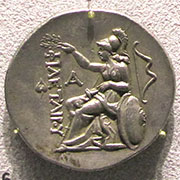
Reverse side of a silver
tetradrachm of Eumenes I,
depicting seated Athena
Nikephoros, patron deity
of Pergamon, holding the
crown of victory over the
name "ΦΙΛΕΤΑΙΡΟΥ"
(Philetairou).
Altes Museum, Berlin. |
| |
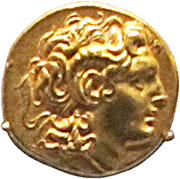
Gold stater of Lysimachus,
depicting Alexander the
Great wearing ram's horns,
the symbol of Zeus Ammon.
Minted in Miletus,
circa 297-281 BC.
Altes Museum, Berlin. |
| |
| |
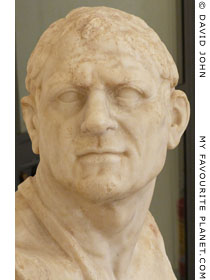
Detail of a marble bust thought
to be a portrait of Lysimachus.
Augustan copy (23 BC - 14 AD)
of a 2nd century BC original.
National Archaeological Museum,
Naples. Inv. No. 6141. |
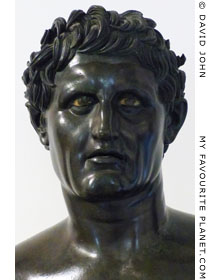
Bronze bust of Seleucus I
Nicator. Found in the Villa
of the Papyri, Herculaneum.
Height 56 cm.
National Archaeological Museum,
Naples. Inv. No. 5590. |
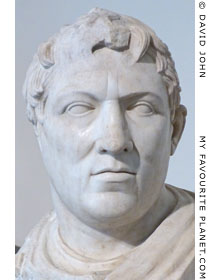
Marble bust of Philetaerus.
Found in the Villa of the
Papyri, Herculaneum.
Height 43 cm.
National Archaeological Museum,
Naples. Inv. No. 6148. |
|
| |
| Interest in the lives and careers of Hellenistic rulers, continued into the Roman Imperial period. Their portraits were collected and copied and displayed in the villas and palaces of the rich and powerful. |
|
| |
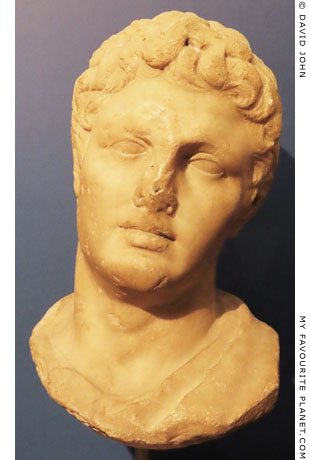
A marble head thought to be an idealized
portrait of a Hellenistic ruler, perhaps
Philetaerus as a young man.
300-200 BC. From Anatolia (Asia Minor).
Height 45 cm.
Rijksmuseum van Oudheden, Leiden,
Netherlands. Inv. No. Pb 135. Bequest
of Gerard van Papenbroek (1672-1743). |
|
|
|
| |
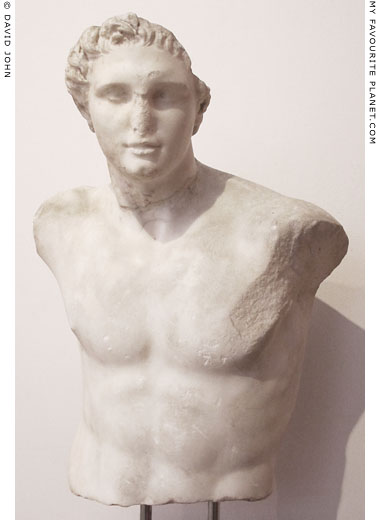
The head and upper torso of a Hellenistic marble
statue of a young man, perhaps an athlete.
Found in Pergamon in 1926. Height 58 cm,
width 40 cm, depth 29 cm. Height of head 17 cm.
Izmir Museum of History and Art. Inv. No. 571. |
| |
Pergamon
gallery 2 |
Notes, references and links |
 |
|
1. Lysimachus, "King of Thrace"
Lysimachus only ruled over the Hellenized coastal areas of Thrace; much of the interior was still controlled by Thracian tribes. Seuthes III (Greek, Σεύθης, ruled circa 331-300 BC), ruler of the Odrysian kingdom, proved a challenge for Lysimachus. They engaged in at least two battles, the results of which were inconclusive, and it is thought that they made a peace treaty.
The Thracians were the first to put portraits of their rulers on coins, even before the Macedonians.
2. Lysimachus' treasure in Pergamon
Strabo (Στράβων, 64/63 BC – circa AD 24 AD), Greek historian, geographer and philosopher from Amaseia in Pontus (today Amasya, Turkey).
Strabo, The Geography, Book 13, chapter 4, section 1. Edited by H. L. Jones. Harvard University Press, Cambridge, MA; William Heinemann Ltd, London, 1924. At Perseus Digital Library.
3. Ainos, Thrace
Ainos (Αίνος; today Enez, Turkey), a Thracian port east of the mouth of the River Evros, east of modern Alexandroupoli (ancient Sale). See History of Alexandroupoli. |
|
|
Maps, photos and articles: © David John,
except where otherwise specified.
Additional photos: © Konstanze Gundudis
All photos and articles are copyright protected.
Images and materials by other authors
have been attributed where applicable.
Please do not use these photos or articles without permission.
If you are interested in using any of the photos for your website,
project or publication, please get in contact.
Higher resolution versions are available on request. |
| |
 |
Visit the My Favourite Planet Group on Facebook.
Join the group, write a message or comment,
post photos and videos, start a discussion... |
|
|
| |
|
|
|